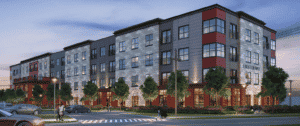
Newburyport approved a smart growth district next to its commuter rail station in 2015, and MINCO Development broke ground in 2018 on the 76-unit One Boston Way. Image courtesy of MINCO Development
A new analysis shows what’s at stake under Massachusetts’ transit-oriented zoning reform, potentially opening up nearly 31,000 acres near MBTA stations in Greater Boston for multifamily development.
The real estate is located in 38 suburbs that currently don’t allow by-right multifamily development near transit stations. A component of the economic development bill approved by state legislators in early January requires all communities to allow multifamily projects with at least 15 units per acre by-right within a half-mile of at least one MBTA station.
“This is a very reasonable way for the state to encourage municipalities to create opportunities to live there and to create good transit-oriented development,” said Tim Reardon, director of data services for Metropolitan Area Planning Council.
The measure is hailed as an important step in spreading significant housing production beyond Boston and handful of nearby cities. But it faces last-minute pushback from Massachusetts Municipal Association, which blasted imposing a “one-size-fits-all” scheme on all 175 communities with MBTA stations and urged Gov. Charlie Baker to veto the transit zoning element.
Baker ultimately signed the bill last week with the transit zoning provision intact.
A Threat to Withhold Funding
Previous state initiatives to spur housing production near transit have relied on incentives, in the form of payments to communities of up to $600,000 per housing unit approved. But the state’s six-year-old Chapter 40R law has received lukewarm support from local communities. Fewer than 3,800 housing units were built or permitted statewide from the law’s passage in 2004 through 2019, according to the state Department of Housing and Community Development.
By contrast, the city of Boston approved more than 10,000 housing units in 2020 alone. Quincy, Revere and Malden led Boston suburbs in recent apartment construction, having completed nearly 4,500 units since 2016, according to a RentCafe study.
The new approach adds financial penalties for communities that fail to rezone for transit-oriented housing, making them ineligible to receive funds from the MassWorks infrastructure program, local capital projects fund and the state’s housing choice initiative.
“That is a great step in the right direction to get people to look at where housing should go,” said Sandi Silk, senior vice president at Jefferson Apartment Group. “There’s a lot of opportunities out there, but the biggest challenge is community resistance.”
‘NIMBYs Alive and Well’
One such opportunity slipped away in Needham after Jefferson Apartment Group sought to build 148 apartments on a commercial parcel near the Needham Junction commuter rail station. Town meeting voters overwhelmingly rejected the rezoning in 2019. Jefferson is not pursuing the development, Silk said.
“The NIMBYs are alive and well throughout the commonwealth,” she said. “The rhetoric at Town Meeting in Needham was aggressively anti-development and anti-schoolchildren, to be honest. People said, ‘We paid a lot of money to get to Needham, and we don’t want these people coming here.’”
Developers say multiple sites near suburban MBTA stations would be attractive for multifamily projects if the law is enacted, particularly as demand for urban rental housing has declined during the COVID-19 pandemic.
Brookline-based City Realty has concentrated almost exclusively on transit-oriented projects in Boston, Somerville and Cambridge, but good sites in the suburbs are hard to find, said Clifford Kensington, City Realty’s director of acquisitions. The mandate to allow by-right projects would expand the list of good development sites, unless communities try to skirt the intent of the law with other regulations such as large setbacks or parking ratios that make projects harder to permit.
“I don’t think you’re going to see seven-story buildings in downtown Wellesley,” Kensington said. “But if you get 1,800-square-foot townhouses, that’s still a huge benefit.”
A New Lens to View Zoning
Metropolitan Area Planning Council used its Zoning Atlas to analyze the bill’s potential effects in its 64 member communities, all of which have at least one MBTA station. The online tool, which went live in December, is the first comprehensive database of zoning regulations in Greater Boston.

Steve Adams
“We were trying to create a picture of what the zoning is across the region, and understand where there are housing opportunities and which communities are not creating opportunities,” MAPC’s Reardon said. “This is just a matter of good government and fairness, so people can look at the zoning and see what’s allowed. Too often it’s buried in PDFs and old paper maps.”
More than half of the communities require special permits or other approvals for multifamily projects with at least 15 units per acre within a half-mile of stations, according to MAPC analysis.
The remaining 26 communities meet the bill’s requirements, with 13,500 acres available for development. But nearly 10,000 of those acres are located in Boston, Cambridge and Somerville, MAPC noted.




 |
| 

